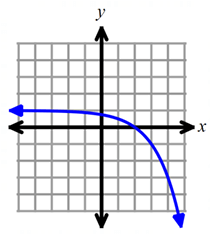FINDING DOMAIN AND RANGE FROM THE GRAPH OF AN EXPONENTIAL FUNCTION
Exponential function will be in any of the following forms.
y = bx
(or)
y = abx
(or)
y = abx-h + k
Domain :
Domain of exponential function is all real values (-∞, ∞).
Range :
(k, ∞) or (-∞, k) can be any one of them, based on exponential growth or decay can be decided.
Exponential growth or decay :
If b > 0 for growth and 0 < b < 1 when it is decay

Horizontal asymptotes :
The exponential function which is in the form
y = abx-h + k
x = k is the horizontal asymptote.
Identify the domain and range for each graphed exponential function.
Problem 1 :

Solution :
Domain is all real numbers (-∞, ∞).
By finding horizontal asymptote, it is simple to fix the range. When we observe the graph, the horizontal asymptote is y = 0.
So, the range is (-∞, 0).
Problem 2 :

Solution :
Domain is all real numbers (-∞, ∞).
By finding horizontal asymptote, it is simple to fix the range. When we observe the graph, the horizontal asymptote is y = -4.
So, the range is (-4, ∞).
Problem 3 :

Solution :
Domain is all real numbers (-∞, ∞).
When we observe the graph, the horizontal asymptote is y = 1.
So, the range is (-∞, 1).
Problem 4 :

Solution :
Domain is all real numbers (-∞, ∞).
When we observe the graph, the horizontal asymptote is y = 4.
So, the range is (-∞, 4).
Problem 5 :

Solution :
Domain is all real numbers (-∞, ∞).
When we observe the graph, the horizontal asymptote is y = -3.
So, the range is (-3, ∞).
Graph the functions for the given table shown for each questions.

i) Is the function increasing or decreasing
ii) Find the domain and range of the function.
Problem 6 :
f(x) = 4x
Solution :
By applying the values of x one by one from the table.
|
When x = -3 f(x) = 4x f(-3) = 4-3 = 1/64 |
When x = -2 f(x) = 4x f(-2) = 4-2 = 1/16 |
When x = -1 f(x) = 4x f(-1) = 4-1 = 1/4 |
|
When x = 0 f(x) = 4x f(0) = 40 = 1 |
When x = 1 f(x) = 4x f(1) = 41 = 4 |
When x = 2 f(x) = 4x f(2) = 42 = 16 |
When x = 3
f(x) = 4x
f(3) = 43
= 64
(-3, 1/64) (-2, 1/16) (-1, 1/4) (0, 1) (1, 4) (2, 16) and (3, 64)

i) By observing the graph from left to right, it is going up. Then it is increasing function.
Horizontal asymptote is y = 0
ii) Domain is all real numbers (-∞, ∞).
Range is (0, ∞).
Problem 7 :
f(x) = 0.4x
Solution :
By applying the values of x one by one from the table.
|
When x = -3 f(x) = 0.4x f(-3) = (0.4)-3 = 1/0.064 |
When x = -2 f(x) = 0.4x f(-2) = (0.4)-2 = 1/0.16 |
When x = -1 f(x) = 0.4x f(-1) = (0.4)-1 = 1/0.4 |
|
When x = 0 f(x) = 0.4x f(0) = (0.4)0 = 1 |
When x = 1 f(x) = 0.4x f(1) = (0.4)1 = 0.4 |
When x = 2 f(x) = 0.4x f(2) = (0.4)2 = 0.16 |
When x = 3
f(x) = 0.4x
f(3) = (0.4)3
= 0.064
Plotting the points, (-3, 1/0.064) (-2, 1/0.16) (-1, 1/0.4) (0, 1) (1, 0.4) (2, 0.16) (3, 0.064).

i) By observing the graph from left to right, it is falling down. Then it is decreasing function.
Horizontal asymptote is y = 0
ii) Domain is all real numbers (-∞, ∞).
Range is (0, ∞).
Recent Articles
-
Finding Range of Values Inequality Problems
May 21, 24 08:51 PM
Finding Range of Values Inequality Problems -
Solving Two Step Inequality Word Problems
May 21, 24 08:51 AM
Solving Two Step Inequality Word Problems -
Exponential Function Context and Data Modeling
May 20, 24 10:45 PM
Exponential Function Context and Data Modeling